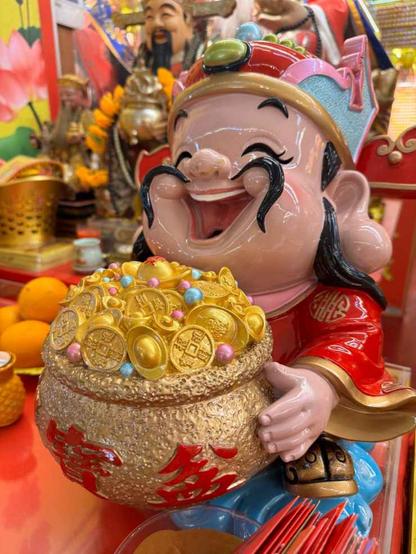Zhengyi Tao/Dao
In pinyin: Zheng Yi Dao. It’s also known as: the Way of Orthodox Unity, Teaching of the Orthodox Unity, & Branch of the Orthodox Unity.
This is a Chinese Taoist movement that traditionally refers to the same Taoist lineage as: the Way of the Five Pecks of Rice & Way of the Celestial Masters. But in the period of the Tang Dynasty & its history thereafter.
The leader of Zhengyi Taoism is known as a Celestial Master, like in the Way of Celestial Masters (Tianshi Dao).
The term Zhengyi (Orthodox Unity) has been used since Taoism became an organized religion in 142 AD. This was when Taishang Laojun granted the Covenant with the Powers of Orthodox Unity (zhengyi mengwei) on Zhang Daoling. Zhang Daoling was a Chinese Taoist religious leader during the Eastern Han dynasty. He founded the Way of the Five Pecks of Rice millenarian movement.
Zhang’s followers called his teachings the Way of the Five Pecks of Rice, while the Six Dynasties Period. The Southern Taoists called it the Way of the Celestial Masters. The Covenant, Five Pecks of Rice, & Celestial Masters all refer to the Zhengyi branch of Taoism but in different periods.
Celestial Master communities suffered from many migrations in the late Three Kingdoms & Five Dynasties & Ten Kingdoms periods. Cao Cao resettled them in the North. Then they joined mass migrations to the South after the loss of Northern China in 317 to the Uprising of the Five Barbarians.
In the 5th century Abridged Codes for the Taoist Community, Lu Xiujing lamented that Taoist Assemblies no longer observed the proper rules & the position of libationer had become hereditary. A libationer is a religious official that’s responsible for leading pa6rishes & performing rituals.
By the Tang Dynasty, the title of Celestial Master had been degraded to where ANY prominent Taoist could claim the title. Celestial Master priests no longer figured prominently in Taoist texts.
Emperor Xuanzong (7 12-756) canonized the first Celestial Master, Zhang Daoling, during his reign. This didn’t have any effect/benefit to the original base of Celestial Masters in Sichuan. It did, however, benefit a temple in the Jiangnan area of Jiangxi Province.
This temple was located at Mount Longhu. This is claimed to be the spot where Zhang Daoling had gotten the Tao & where his descendants still lived. Recognized by the emperor as the legit descendants of Zhang Daoling, these new Celestial Masters established a new patriarchy at their base at Mount Langhu.
The importance of the Zhangyi school grew during the Song Dynasty. The Celestial Master frequently got imperial appointments. In 1239, the Southern Song Dynasty‘s Emperor Lizong commanded the 35th Zhang Keda to unite 3 schools: Lingbao School, Shangqing School, & Zhengyi Dao. The new unified school kept the Zhengyi name & stayed based in Mount Longhu.
Shortly after the schools were united, the Mongols, under Kublai Khan, conquered the Southern Song Dynasty. Kublai Khan established the Yuan Dynasty in China. Kublai Khan accepted the claim that the Celestial Master of Mount Longhu was descended from Zhang Daoling. Kublai Khan also granted the school the right to control affairs relating to Taoism in the Jinagnan area.
In 1304, as result of Zhengyi Dao‘s increased importance the Mongols, all of the Taoist schools (except the Quanzhen school) were united under the banner of the Zhengyi School, with the 38th Celestial Master, Zhang Yucai, as the spiritual leaders.
The founding of the Ming Dynasty in 1368 started at the beginning of a long decline of the power of Zhengyi Taoism. The first Ming ruler, the Hongwu Emperor (1368-98), suppressed the use of the title of “Celestial Master” among the Zhengyi School.
By the Daoguang period (1821-50) of the Qing Dynasty, relations between the court & the Celestial Masters came to an end. The activities became more localized to regions in which the school was particularly important.
Even though their court association was over the Celestial Master themselves still had a great deal of prestige, & importance, among Taoists throughout China. This importance, that arose from the belief that they were descended from Zhang Daoling, was evident when the Celestial Master traveled & attracted crowds of people wherever they went.
Unlike prior incarnations of the Celestial Masters, like the school based at Louguan, the Zhengyi Taoists didn’t venerate Laozi as a god. They viewed him as the ancestor of the school’s teaching.
There are 2 main types of rituals performed by the Zhengyi Taoists: the jiao (offering) & zhai (retreat) rituals. The zhai rituals are performed as a way to gain benefits through purification & abstinence. They usually take place immediately after the jiao ritual.
In performing a ritual, the participant recites a litany of repentance first. Then notify the deities of the merits gained through repentance by submitting a document to Heaven. When the zhai ritual is done, the jiao ritual begins in which deities are given offerings & are thanked.
The jian ritual is usually performed over 3 days. A lot of the ritual is performed by priests in a temple. But can also involve religious processions through the city, musical performances & a mass offering in front of the temple.
One-Time Monthly YearlyMake a one-time donation
Make a monthly donation
Make a yearly donation
Choose an amount
$1.00 $5.00 $10.00 $1.00 $5.00 $10.00 $5.00 $10.00 $15.00Or enter a custom amount
$Your contribution is appreciated.
Your contribution is appreciated.
Your contribution is appreciated.
DonateDonate monthlyDonate yearly
#1239 #1304 #1368 #1398 #142AD #1821 #1850 #317 #5thCentury #712 #756 #AbridgedCodesForTheTaoistCommunity #BranchOfTheOrthodoxUnity #CaoCao #CelestialMaster #CelestialMasters #China #ChineseTaoism #Covenant #DaoguangPeriod #EasternHanDynasty #EmperorLizong #EmperorXuanzong #FiveDynasties #HongwuEmperor #JiangxiProvince #KublaiKhan #Laozi #Libationer #LingbaoSchool #Louguan #LuXiujing #MillenarianMovement #MingDynasty #Mongols #MountLonghu #NorthernChina #Pinyin #PowersOfOrthodoxUnity #QingDynasty #QuanzhenSchool #ShangqingSchool #Sichuan #SixDynasties #SongDynasty #SouthernSongDynasty #SouthernTaoists #taishangLaojun #TangDynasty #Tao #TeachingOfTheOrthodoxUnity #TenKingdoms #ThreeKingdoms #TianshiDao #UprisingOfTheFiveBarbarians #WayOfOrthodoxUnity #WayOfTheCelestialMasters #WayOfTheFivePecksOfRice #YuanDynasty #Zhai #ZhangDaoling #ZhangKeda #ZhangYucai #Zhengyi #ZhengyiDao #ZhengyiMengwei #ZhengyiTaoism

